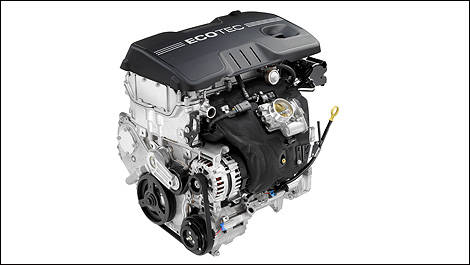Press release
NEW YORK - The all-new, five-passenger 2010 GMC Terrain joins the rapidly growing list of vehicles with GM's direct injected (DI) engines that use less fuel, make more power and produce fewer emissions. The Terrain brings to 18 the number of North American GM models that will feature DI in 2010 - more than any other manufacturer.
"Direct injection is a key component of GM's Advanced Propulsion Technology Strategy that uses multiple technology pathways to achieve increased efficiency and the diversification of energy sources," said Tom Stephens, vice chairman, Global Product Development. "Because there is no single solution, we're applying advanced technology where it makes the most sense for customers in regard to fuel efficiency, performance and cost. The efficiency gain with direct injection represents a great technological value that customers can benefit from immediately."
Both of the Terrain's available engines - a new 2.4L four-cylinder and a 3.0L V-6 - come standard with DI, with 2.4L-equipped models estimated at 30 mpg on the highway (EPA certification pending). That puts GMC's new crossover SUV at the top of its segment in highway fuel economy.
Additional new GM models with DI include the 2010 Buick LaCrosse luxury sedan, the sporty 2010 Chevy Camaro, the redesigned 2010 Cadillac SRX and the 2010 Chevy Equinox crossover. They contribute to GM's global initiative that will see eight distinct DI engines offered in 38 vehicle models around the world next year.
"Direct injection is a near-term solution - along with hybrids and biofuels like E85 - that fits well within GM's current portfolio, but our strategy envisions mid- and long-term powertrain solutions that will ultimately reduce vehicle emissions to zero, increase fuel efficiency dramatically and displace petroleum as the primary energy source," said Stephens. "Vehicles like the 2011 Chevrolet Volt extended-range electric vehicle and our advanced fuel cell-electric prototypes are tangible examples of GM's vision."
How direct injection works
In a conventional port fuel injected engine, air and fuel are mixed before they enter the combustion chamber. With GM's DI engines, fuel is sprayed directly into the cylinder where it is mixed with air. As the piston approaches top-dead center, the mixture is ignited by the spark plug; and when the fuel vaporizes in the cylinder, the air and fuel mixture is cooled. This enables the use of a higher compression ratio in the combustion chamber, which improves the engine's power and efficiency.
On cold starts, direct injection can be controlled to create a richer air/fuel mixture around the spark plug, making it easier to ignite in a cold engine. This results in a smoother operation of the engine and lower emissions during the cold start and warm-up, when most harmful tailpipe emissions are typically created. GM's direct injected engines reduce cold-start vehicle emissions by 25 percent.
NEW YORK - The all-new, five-passenger 2010 GMC Terrain joins the rapidly growing list of vehicles with GM's direct injected (DI) engines that use less fuel, make more power and produce fewer emissions. The Terrain brings to 18 the number of North American GM models that will feature DI in 2010 - more than any other manufacturer.
 |
| GM's new Ecotec 2.4L I-4 VVT DI engine for the 2010 GMC Terrain. |
"Direct injection is a key component of GM's Advanced Propulsion Technology Strategy that uses multiple technology pathways to achieve increased efficiency and the diversification of energy sources," said Tom Stephens, vice chairman, Global Product Development. "Because there is no single solution, we're applying advanced technology where it makes the most sense for customers in regard to fuel efficiency, performance and cost. The efficiency gain with direct injection represents a great technological value that customers can benefit from immediately."
Both of the Terrain's available engines - a new 2.4L four-cylinder and a 3.0L V-6 - come standard with DI, with 2.4L-equipped models estimated at 30 mpg on the highway (EPA certification pending). That puts GMC's new crossover SUV at the top of its segment in highway fuel economy.
Additional new GM models with DI include the 2010 Buick LaCrosse luxury sedan, the sporty 2010 Chevy Camaro, the redesigned 2010 Cadillac SRX and the 2010 Chevy Equinox crossover. They contribute to GM's global initiative that will see eight distinct DI engines offered in 38 vehicle models around the world next year.
"Direct injection is a near-term solution - along with hybrids and biofuels like E85 - that fits well within GM's current portfolio, but our strategy envisions mid- and long-term powertrain solutions that will ultimately reduce vehicle emissions to zero, increase fuel efficiency dramatically and displace petroleum as the primary energy source," said Stephens. "Vehicles like the 2011 Chevrolet Volt extended-range electric vehicle and our advanced fuel cell-electric prototypes are tangible examples of GM's vision."
How direct injection works
In a conventional port fuel injected engine, air and fuel are mixed before they enter the combustion chamber. With GM's DI engines, fuel is sprayed directly into the cylinder where it is mixed with air. As the piston approaches top-dead center, the mixture is ignited by the spark plug; and when the fuel vaporizes in the cylinder, the air and fuel mixture is cooled. This enables the use of a higher compression ratio in the combustion chamber, which improves the engine's power and efficiency.
On cold starts, direct injection can be controlled to create a richer air/fuel mixture around the spark plug, making it easier to ignite in a cold engine. This results in a smoother operation of the engine and lower emissions during the cold start and warm-up, when most harmful tailpipe emissions are typically created. GM's direct injected engines reduce cold-start vehicle emissions by 25 percent.


